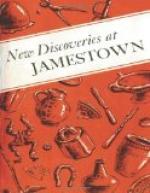[Illustration: A physician bleeding A patient. (Conjectural sketch by Sidney E. King.)]
[Illustration: A few items unearthed at Jamestown which were used by doctors and apothecaries. Included are drug jars, ointment pot, bleeding bowl, mortar and pestle fragments, glass vials, and portions of surgical instruments.]
[Illustration: Enjoying A Smoke in A tavern, about 1625. (Conjectural sketch by Sidney E. King.)]
[Illustration: A few of thousands of clay pipe fragments unearthed at Jamestown. The ones Shown Range in date from 1600 to 1700. During this 100-year period, pipes developed from small bowls to fairly large ones.]
SMOKING
The first colonists were quite familiar with the use of tobacco, and it is believed that many of them smoked clay pipes. Evidently there was some demand for tobacco pipes by the early planters as one of the men, Robert Cotten, who reached Jamestown in January 1608, was a tobacco pipemaker.
In 1611-12 John Rolfe had experimented with tobacco plants in Virginia (he used Virginia plants as well as varieties from the West Indies and South America), and was successful in developing a sweet-scented leaf. It became popular overnight, and for many years was the staple crop of the infant colony. There was a prompt demand for the new leaf in England, and its introduction there was an important factor in popularizing the use of clay pipes. After 1620 the manufacture of white clay pipes in England increased by leaps and bounds.
It is estimated that there are over 50,000 clay pipe bowls and stem fragments in the Jamestown collection—perhaps the largest assemblage of its kind extant. Pipe bowls and stem fragments were found wherever excavations were made, indicating that the smoking of clay pipes was an extremely popular custom at Jamestown.
During the 1607-1700 period, pipe-bowls developed in size from small to fairly large. In most examples that have been found, the early pipes have larger stem-holes than pipes made during the latter years of the century.
Although the majority of pipes found at Jamestown were imported from England, some were made in Holland. Some of the colonists made their pipes in Virginia from local clay, either by pipemaking machines or by handmolding. The English and Dutch pipes were white in color, whereas the local product was brown. As they were fragile, not a single complete pipe has been unearthed at Jamestown.




